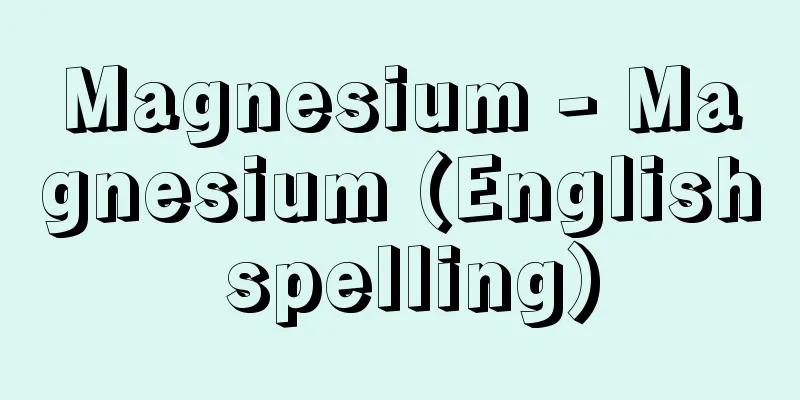Magnesium - Magnesium (English spelling)

|
It belongs to group 2 of the periodic table and is one of the alkaline earth metal elements. historyThe compound, sulfate heptahydrate, or Epsom salt, was isolated by N. Groove in 1695, and in 1707, MB Valentine isolated basic magnesium carbonate from the mother liquor after processing Chilean saltpeter. This was used as a panacea under the name of magnesia alba (alba means white). The word magnesia is the name of an ancient city in Lydia, a kingdom in Asia Minor, and is thought to be the origin of the element magnesium, but it seems to have been given to the names of several different substances in the past. Magnesia is now known as magnesium oxide, but it was confused with lime, or calcium oxide, until J. Black of England revealed this in 1755. In 1808, H. Davy of England obtained magnesium amalgam by electrolysis of magnesium oxide and distilled it to isolate the metal. Furthermore, in 1831, Antoine-Alexandre Bussy (1794-1882) of France succeeded in obtaining a nearly pure block of the metal by reducing magnesium chloride with potassium. In 1833, M. Faraday of England and in 1852, Bunsen of Germany obtained metallic magnesium by fusion electrolysis of magnesium chloride, but it was not until 1886, when Germany succeeded in fusion electrolysis of carnallite ( KCl.MgCl2.6H2O ), that it became possible to produce it industrially. [Torii Yasuo] ExistenceMagnesium does not occur naturally in a free state, but is distributed widely and in large quantities across the globe. Its main ores are magnesite, carnallite, dolomite, talc, serpentine, and asbestos, but it is also found in pyroxene and amphibole. It also exists as a soluble salt in seawater and mineral springs. With the development of an efficient and economical method of extraction from seawater, the supply of magnesium is considered to be virtually limitless. It is also found as chlorophyll in the chlorophyll of plants, and plays an important role in the physiology of animals. [Torii Yasuo] Manufacturing methodIndustrially, there are methods such as the molten salt electrolysis method of anhydrous magnesium chloride, high-temperature reduction with carbon, or reduction using carbide or ferrosilicon. Anhydrous magnesium chloride is extracted directly from carnallite, bittern, or seawater, but it can also be made by chlorinating magnesium oxide. Magnesium chloride, a by-product of titanium production using the Kroll process, is also used. The electrolytic bath is in the form of MgCl2 ·NaCl·KCl or MgCl2 ·2NaCl, etc., and electrolysis is carried out at 660-750°C. The electrolytic cell is lined with iron or firebrick, with a graphite anode and iron cathode. The reduction method using ferrosilicon is called the Pigeon process after its inventor. Dolomite MgCO3 - CaCO3 is fired and 75% silicon ferrosilicon (iron silicon) is added to make a briquette, which is then placed in a heat-resistant steel retort and thermally reduced at 1200°C. This is then distilled in a vacuum of about 0.001 mm of mercury to extract the magnesium. This method produces a product with a purity of about 99.7%. Reduction with carbon is carried out at 1900-2400℃, the resulting magnesium vapor and carbon monoxide are quenched with a large amount of hydrogen gas, and the resulting magnesium powder is distilled and melted to produce ingots (purity about 90%). This method is dangerous to operate and does not produce very good purity, so it is rarely used today. The purity of electrolytic magnesium is about 99.90-99.97%, and impurities include copper, manganese, iron, silicon, lead, etc. To remove these, a product with a purity of 99.99% is obtained by vacuum distillation at a relatively low temperature. [Torii Yasuo] natureIt is a light, silvery-white metal that is quite ductile and can be made into thin foil or wire. In air, a thin oxide film forms on the surface, gradually dulling the luster, but this protects the inside and makes it relatively stable. Therefore, ordinary metallic magnesium does not react with cold water, but only with hot water. Mg + H2O -> MgO + H2 Mg+2H 2 O―→Mg(OH) 2 +H 2 When thin foil or powder is heated vigorously in air, it burns with a brilliant light, producing magnesium oxide, some of which becomes magnesium nitride. It reacts directly with nitrogen at high temperatures, and also with halogen elements, sulfur, carbon, silicon, and boron at the appropriate temperatures. [Torii Yasuo] ApplicationsIt is well known that magnesium ribbon or magnesium powder is used in flash lamps, getters, heat insulation materials, etc. It is also used as a reducing agent for producing pure metals such as titanium, zirconium, and beryllium, and as an electrolytic protection material. Various magnesium alloys are the lightest of all practical alloys, and are widely used to take advantage of this characteristic. It is also used as a Grignard reagent. [Torii Yasuo] Magnesium and the human bodyThe human body contains about 25 grams of magnesium, 60-65% of which is found in bones, and the rest is distributed in muscles, brain, nerves, and body fluids. Its physiological functions include forming bones and teeth, and being a component of many enzymes, it is necessary for activating enzyme actions in carbohydrate and lipid metabolism, and for synthesizing proteins in the body. It has a similar effect to calcium, and is known to be antagonistic to calcium, especially in the skeleton. It is distributed throughout animals and plants, and most of the required amount can be obtained from a normal diet. Deficiency symptoms include elevated blood lipids, loss of appetite, and muscle pain. Excessive magnesium can develop due to renal dysfunction. The Dietary Reference Intakes for Japanese (Ministry of Health, Labor, and Welfare) sets guideline and recommended amounts for the amount to be taken from food, as well as upper limits for intake from sources other than regular foods. [Tomomi Kono and Yonago Yamaguchi] "Magnesium Technology Handbook, edited by the Japan Magnesium Association Magnesium Technology Handbook Editorial Committee (2000, Kalos Publishing)" ▽ "Learn about Magnesium from the Basics - The Lightest Metal Structural Material, by Shigeru Nemoto (2002, Industrial Research Institute)" ▽ "Encyclopedia of Minerals, edited by Yoshinori Itokawa (2003, Asakura Publishing)" ▽ "Magnesium Processing Technology, edited by the Japan Society for Technology of Plasticity (2004, Corona Publishing)" ▽ "Magnesium Basics and Clinical Practice: Its Role in Daily Medical Treatment and Perioperative Period, edited by Yoshio Tonosawa (2005, Shinko Trading Medical Book Publishing Division)" ▽ "The Role of Magnesium You Should Know: Diet for Preventing Osteoporosis, Heart Disease (Ischemic), and Obesity, by Yoza Miyake, Revised Edition (2005, Keyaki Publishing)" ▽ "Dietary Reference Intakes for Japanese People, 2015 Edition - Report of the Ministry of Health, Labor, and Welfare's "Dietary Reference Intakes for Japanese People" Review Committee Report (2014, Daiichi Publishing)" [References] | | [Supplementary information] | |©Shogakukan "> Periodic Table ©Shogakukan "> Magnesium manufacturing process Source: Shogakukan Encyclopedia Nipponica About Encyclopedia Nipponica Information | Legend |
|
周期表第2族に属し、アルカリ土類金属元素の一つ。 歴史化合物としては硫酸塩七水和物すなわちエプソム塩が、1695年にN・グルーによって単離されており、また1707年にはバレンチンM. B. Valentineが、チリ硝石を処理したあとの母液から塩基性炭酸マグネシウムを取り出している。これはマグネシアアルバmagnesia albaの名で万能薬として用いられていた(アルバは白いを意味する)。マグネシアmagnesiaということばは小アジアの王国リディアの一古代都市の名称で、元素名としてのマグネシウムの語源と考えられるが、古くはいくつかの異なった物質の名称に冠せられていたようである。マグネシアは今日では酸化マグネシウムをさすが、これとても1755年にイギリスのJ・ブラックが明らかにするまでは石灰すなわち酸化カルシウムと混同されていた。1808年イギリスのH・デービーは、酸化マグネシウムの電解によってマグネシウムアマルガムを得、これを蒸留して金属を単離している。さらに1831年にフランスのビュッシーAntoine-Alexandre Bussy(1794―1882)は、塩化マグネシウムをカリウムで還元することによって、ほぼ純粋な金属を塊状で得ることに成功した。1833年にはイギリスのM・ファラデーが、また、1852年にはドイツのブンゼンが、塩化マグネシウムの融解電解によって金属マグネシウムを得ているが、1886年にドイツでカーナル石KCl・MgCl2・6H2Oの融解電解に成功して以来、工業的に生産されるようになった。 [鳥居泰男] 存在天然に遊離状態では産出しないが、地球上に広く多量に分布している。菱苦土(りょうくど)石、カーナル石、苦灰石(ドロマイト)、滑石、蛇紋(じゃもん)石、石綿などが主要な鉱石であるが、輝石、角閃(かくせん)石などにも含まれる。また可溶性塩類として海水、鉱泉などにも存在している。海水からの効率的・経済的な抽出法が考案されたことにより、マグネシウムの供給は事実上無限と考えられる。また、植物の葉緑素の中にはクロロフィルとして含まれ、動物の生理にも重要な役割を果たしている。 [鳥居泰男] 製法工業的には無水塩化マグネシウムの融解塩電解法と、炭素による高温還元あるいはカーバイド、フェロシリコンなどによる還元法がある。無水塩化マグネシウムは、カーナル石、にがりあるいは海水から直接とるが、酸化マグネシウムを塩素化してつくることもある。また、クロール法によるチタン製造の際の副生塩化マグネシウムも使われる。電解浴はMgCl2・NaCl・KClあるいはMgCl2・2NaClなどの形で660~750℃で電解する。電解槽は鉄または耐火れんが張りで、陽極は黒鉛、陰極は鉄製である。 フェロシリコンによる還元法は、発明者の名にちなんでピジョン法とよばれている。ドロマイトMgCO3・CaCO3を焼成したものに75%ケイ素のフェロシリコン(ケイ素鉄)を加えてブリケット(団鉱)とし、耐熱鋼のレトルトの中に入れて1200℃で熱還元する。これを水銀柱0.001ミリメートル程度の真空で蒸留し、マグネシウムを留出させる。この方法で純度99.7%程度のものが得られる。 炭素による還元は1900~2400℃で行い、生成したマグネシウム蒸気と一酸化炭素を大量の水素ガスで急冷し、得られたマグネシウム粉末を蒸留し、融解してインゴットとする(純度約90%)。この方法は操作が危険で純度もあまりよくないので、現在ではほとんど行われていない。 電解マグネシウムの純度は99.90~99.97%程度で、不純物は銅、マンガン、鉄、ケイ素、鉛などである。これらを除去するため、比較的低温で真空蒸留すると99.99%の製品が得られる。 [鳥居泰男] 性質銀白色の軽い金属で、かなりの展延性があり、薄い箔(はく)や細い針金にすることができる。空気中では表面に酸化物の薄い被膜ができるので光沢がしだいに鈍くなるが、それが内部を保護することになるので比較的安定である。したがって通常の金属マグネシウムは冷水とは反応せず、熱水で初めて反応する。 Mg+H2O―→MgO+H2 Mg+2H2O―→Mg(OH)2+H2 薄い箔または粉末を空気中で強熱するとまばゆい光を放って燃え、酸化マグネシウムを生じ、一部は窒化マグネシウムとなる。窒素とは高温で直接反応する。そのほか適当な温度を与えれば、ハロゲン元素、硫黄、炭素、ケイ素、ホウ素などとも直接反応する。 [鳥居泰男] 用途マグネシウムリボンあるいはマグネシウム粉末としてフラッシュランプ、ゲッター、断熱材などに用いられることはよく知られている。また、チタン、ジルコニウム、ベリリウムなどの純金属製造用還元剤、電気防食などにも使われる。各種マグネシウム合金は実用合金のなかでもっとも軽いので、その特徴を生かして広く使われている。グリニャール試薬としての用途もある。 [鳥居泰男] 人体とマグネシウムマグネシウムは、人体に約25グラム含まれ、骨にその60~65%が存在し、残りは筋肉、脳、神経、体液などに分布している。生理作用は、骨や歯を形成し、多くの酵素の形成成分として糖質・脂質の代謝などにおける酵素作用の活性化、体内でのタンパク質の合成などに必要である。カルシウムと似た作用があり、とくに骨格においてはカルシウムと拮抗(きっこう)性があることが知られている。食品には動植物全体に分布し、普通の食事から必要な量がほぼとれている。欠乏症は血中脂質の上昇、食欲不振、筋肉痛などがある。腎(じん)機能障害によって過剰症が発症することがある。「日本人の食事摂取基準」(厚生労働省)により、食事からとるべき量については目安量や推奨量が、また、通常の食品以外からの摂取量の上限量が設定されている。 [河野友美・山口米子] 『日本マグネシウム協会マグネシウム技術便覧編集委員会編『マグネシウム技術便覧』(2000・カロス出版)』▽『根本茂著『初歩から学ぶマグネシウム――一番軽い金属構造材』(2002・工業調査会)』▽『糸川嘉則編『ミネラルの事典』(2003・朝倉書店)』▽『日本塑性加工学会編『マグネシウム加工技術』(2004・コロナ社)』▽『外須美夫編『マグネシウムの基礎と臨床 日常診療および周術期における役割』(2005・真興交易医書出版部)』▽『三宅洋左著『知っておきたいマグネシウムの役割 骨粗鬆症・心疾患(虚血性)・肥満予防のための食事』増補(2005・けやき出版)』▽『菱田明・佐々木敏監修『日本人の食事摂取基準2015年版――厚生労働省「日本人の食事摂取基準」策定検討会報告書』(2014・第一出版)』 [参照項目] | | [補完資料] | |©Shogakukan"> 周期表 ©Shogakukan"> マグネシウムの製造工程 出典 小学館 日本大百科全書(ニッポニカ)日本大百科全書(ニッポニカ)について 情報 | 凡例 |
<<: Magnesium alloy - Magnesium alloy
Recommend
Rahewin
…Another historical work he wrote in his later ye...
Rockefeller (English spelling)
A family of American businessmen. The Rockefeller ...
Paradox - Gyakuri (English spelling) Paradox
When a proposition and its negation are both asser...
Onion - Onion (English spelling)
The English name for onion. There are many cultiv...
Eanna - Eanna
… Examples of Sumerian art are known from the Uru...
Enryaku Ritual Book
It is also called "Ise Taijingu Rites," ...
Hiroshi Ohshita - Hiroshi Ohshita
Professional baseball player (outfielder, left-ha...
Annexation of Korea - カンコクヘイゴ
This refers to the fact that the Treaty on the Ann...
Striped loach (Shimadojou) - Striped loach (English spelling)
A freshwater fish of the family Cobicidae in the o...
Tit‐Bits
A British popular weekly newspaper founded in Manc...
IMRO - Imuro
A secret Macedonian revolutionary organization fo...
Mobilisierung des Kapitals
…The commodification of capital as stock capital ...
Kisumire - Kisumire
A perennial plant of the family Violaceae (APG cl...
Amsterdam Declaration
...As preservation organizations, Italia Nostra w...
Apartment
…A hotel is a structure in which one enters a cou...



![Tsuyazaki [town] - Tsuyazaki](/upload/images/67cc3dc5e9338.webp)





